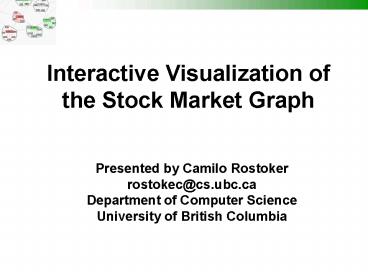Interactive Visualization of the Market Graph - PowerPoint PPT Presentation
Title:
Interactive Visualization of the Market Graph
Description:
Represent inter-cluster relationships. Dynamic graph capabilities ... related clusters should be ... Visualizes different cluster types and their attributes ... – PowerPoint PPT presentation
Number of Views:46
Avg rating:3.0/5.0
Title: Interactive Visualization of the Market Graph
1
Interactive Visualization of the Stock Market
Graph
Presented by Camilo Rostoker rostokec_at_cs.ubc.ca De
partment of Computer Science University of
British Columbia
2
Overview
- Introduction
- The Market Graph
- Motivation
- Visualization Goals
- Solutions Methods
- Future Work
- Conclusion
- Demo
3
Stock Market Data
- Huge amounts of accessible data on a daily basis
- Consists of a variety of fields such as price,
volume, change - Stock price interactions form a complex system
- Want to understand these interactions of the
subsystems
4
Constructing the Market Graph
- From a dataset, compute the correlation matrix
- Convert correlation matrix to a graph, where
- Vertices represent stocks
- Edges represents a relationships between two
stocks - correlation(stock1,stock2) gt THRESHOLD
5
What Are We Visualizing?
- Find clusters/groups of stocks that exhibit
certain trading patterns
- Maximum Cliques
- Highly positively/negatively correlated subsets
of stocks - Independent Sets
- Completely diversified stocks
- Quasi-Cliques/Independent Sets
- Generalizations ? allow for near matches
- Clusters ? Cliques/IS interchangeably
6
Existing Approaches to Visualizing Graph
Structures
- Determine target structures (i.e. clusters) a
priori and use a standard layout algorithm to
show the results - Use a layout algorithm optimized to visually
differentiate target structures - Our approach combine the two
- Find target structures first, but include
additional nodes and edges for context - Then use force-directed layout algorithm to
effectively visualize the results
7
Example Vizster
8
Motivation Usage Scenarios
- Portfolio management (static)
- Real-time market analysis (dynamic)
- Exploratory analysis of trading data to gain new
insights, spot patterns/trends, etc (static)
9
Motivation Visualizing Results from a Real-time
Data-mining Pipeline
Viz Client
Viz Client
10
Visualization Goals
- Visualize different graph structures representing
various patterns and trends - (quasi-)cliques and (quasi-)independent sets
- positively and negatively correlations
- Represent inter-cluster relationships
- Dynamic graph capabilities
- Interaction for efficient data exploration
- Information integration
11
Force-Directed Graph Layout Model
- Create summaries of the graph using the
clusters and their induced subgraphs - Force model spring-embedded layout
- Spring lengths and tensions parameterized to
optimize layout - Highly related clusters should be close
- Independent clusters and minimally related
clusters should be further apart
12
F.D. Model Parameterizations
- Edge Length
- Cluster-Cluster edges (CC)
- intra-cluster edges (shows connectedness of
clusters) - Cluster-Member edges (CM)
- Quasi-cliques ? intra-cluster edges (clique
contribution) - Cliques cluster sizes (more space to larger
clusters) - Tension
- CM edges use constant tight tension
- CC edge tension proportional to of
inter-cluster links
13
Differentiating cluster types
- Correlation Metrics positive, negative,
independent - Color encoded
- Cluster types (quasi-) Cliques and (quasi-)
Independent sets - Transparency-encoding forcluster summary
- Individual members edge length encodes clique
contribution
14
Interaction Information Integration
- Interaction Features
- Geometric pan/zoom
- Display/hide cluster outlines
- Symbol search for quick navigation
- Overview display for global context
- Node context menus provide stock quotes and news
- Stock news from various sources integrated via
RSS feeds - Online quote details and Google search for
provided by opening an external web browser
15
Dynamic graph capabilities
- Receive remote graph updates via socket
connection to a graph update server - Nodes/edges can be added, removed or replaced
- Event-based architecture allows for automatic
processing of new updates - Force-model allows for efficient incremental
layouts when new nodes/edges placed
intelligently
16
Future Work Improvements
- Handle overlapping clusters
- Encode other variables
- i.e. node size could encode trade volume
- Ability to view underlying edge weights
- Ability to optionally view complete underlying
graph - especially the intra-cluster edges
17
Future Work Improvements (2)
- Interactively adding/removing nodes and edges
- Semantic zoom
- FocusContext
- Other clustering methods besides partitioning via
(quasi-)cliques and independent sets
18
Conclusion
- Implemented basic Visualization tool for
exploring the market graph - Visualizes different cluster types and their
attributes - User interaction for pan/zoom, on-demand details
(quotes, news, web search) - Dynamic graph capability to support a real-time
data processing pipeline
19
References
- Jeffrey Heer and Danah Boyd. Vizster Visualizing
online social networks. InfoVis 2005 IEEE
Symposium on Information Visualization, 2005. - Jeffrey Heer, Stuart K. Card, and James A.
Landay. prefuse a toolkit for interactive
information visualization. In CHI 05
Proceedings of the SIGCHI conference on Human
factors in computing systems, pages 421430, New
York, NY, USA, 2005. ACM Press. - Frank van Ham and Jarke J. van Wijk. Interactive
visualization of small world graphs. In
Proceedings of the IEEE Symposium on Information
Visualization, pages 199206, Washington, DC,
USA, 2004. IEEE Computer Society. - Vladimir Boginski, Sergiy Butenko, and Panos M.
Pardalos. Mining market data A network approach.
20
DEMO
21
THE END!
22
(No Transcript)
23
Construct a Similarity Matrix
- Currently, our similarity measure is
where































